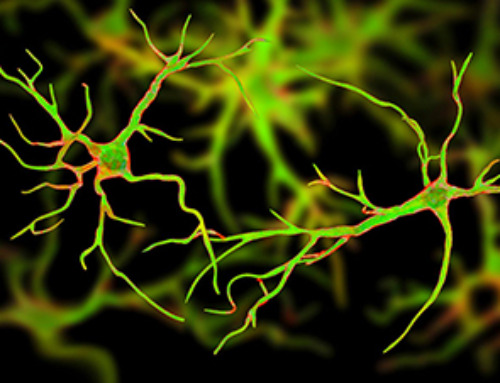Cedars-Sinai Cancer investigators have developed a new nanotechnology-based test that can detect and profile prostate cancers—even in microscopic amounts. Their work, published in the journal Nano Today, suggests that this “liquid biopsy” test could spare many patients unnecessary treatment-related side effects, directing them instead to effective therapies that could prolong their lives.
Cancer of the prostate, a walnut-sized gland just below the bladder, is the most common cancer and second-leading cause of cancer death among U.S. men.
The test developed by Posadas and co-investigators isolates and characterizes extracellular vesicles, also called EVs, from blood samples. EVs are microscopic packets of protein and genetic material that are shed by cells. The EV Digital Scoring Assay can pull these EV packets from the blood with unprecedented efficiency and analyze them in a manner that is faster than any currently available test.
The investigators tested blood samples from 40 patients with prostate cancer and found that the test was able to distinguish cancer localized to the prostate from cancer that had spread to other parts of the body.
Posadas envisions this test being used to help patients who have their prostate gland removed and later experience a rise in levels of prostate-specific antigen (PSA) in their blood. This happens in about 30% of post-surgical patients, and elevated PSA levels can indicate cancer recurrence.
If a remnant of the cancer has been left behind in the prostate bed, where the prostate gland once was, Posadas said focused radiation therapy can cure the disease or delay progression. But that treatment is not without risks.
“The bladder and rectum are near the prostate bed and can be damaged during the course of radiation therapy,” Posadas said. “The risk is only worth it if a man is going to benefit.”
If microscopic cancer deposits have spread outside the prostate area, focused radiation treatment will not prevent disease progression. These deposits, called micro-metastases, are not always detectable, even via the most advanced imaging, but investigators were able to detect them using the EV test.
“This would allow many patients to avoid the potential harms of radiation that isn’t targeting their disease, and instead receive systemic therapy that could slow disease progression,” Posadas said.
In retrospective case studies, investigators tested blood samples taken over time from three prostate cancer patients, including one patient who had undergone focused radiation treatments.
“At the time he was being treated, I was concerned that he was not benefiting,” Posadas said. “And the test results mirrored his clinical behavior and showed that, indeed, the treatments were not effective because he had micro-metastatic disease.”
The test is the latest in a yearslong series of Cedars-Sinai Cancer breakthroughs involving EVs. Posadas said that it could also be adapted to guide treatment as prostate cancer therapies become more targeted at the molecular level, ultimately extending patients’ lives. Posadas and his team of investigators are now working to further refine the test so that it can be studied in greater detail.
“This type of liquid biopsy, coupled with innovations such as our Molecular Twin initiative, is key to next-generation precision medicine that represents the newest frontier in cancer treatment,” said Dan Theodorescu, MD, Ph.D., director of Cedars-Sinai Cancer and the PHASE ONE Distinguished Chair.
“And the type of progress we are making is only possible at an institution such as Cedars-Sinai Cancer, where we have patients, clinicians, scientists and creative engineering minds converging as one unit to address the most challenging problems in cancer.”
Posadas and the team aim to work with local and national partners and hope to see the test come into wide clinical practice in the near future.
News
Multifunctional Nanogels: A Breakthrough in Antibacterial Strategies
Antibiotic resistance is a growing concern - from human health to crop survival. A new study successfully uses nanogels to target and almost entirely inhibit the bacteria P. Aeruginosa. Recently published in Angewandte Chemie, the study [...]
Nanoflowers rejuvenate old and damaged human cells by replacing their mitochondria
Biomedical researchers at Texas A&M University may have discovered a way to stop or even reverse the decline of cellular energy production—a finding that could have revolutionary effects across medicine. Dr. Akhilesh K. Gaharwar [...]
The Stunning New Push to Protect the Invisible 99% of Life
Scientists worldwide have joined forces to build the first-ever roadmap for conserving Earth’s vast invisible majority—microbes. Their new IUCN Specialist Group reframes conservation by elevating microbial life to the same urgency as plants and [...]
Scientists Find a Way to Help the Brain Clear Alzheimer’s Plaques Naturally
Scientists have discovered that the brain may have a built-in way to fight Alzheimer’s. By activating a protein called Sox9, researchers were able to switch on star-shaped brain cells known as astrocytes and turn them into [...]
Vision can be rebooted in adults with amblyopia, study suggests
Temporarily anesthetizing the retina briefly reverts the activity of the visual system to that observed in early development and enables growth of responses to the amblyopic eye, new research shows. In the common vision [...]
Ultrasound-activated Nanoparticles Kill Liver Cancer and Activate Immune System
A new ultrasound-guided nanotherapy wipes out liver tumors while training the immune system to keep them from coming back. The study, published in Nano Today, introduces a biodegradable nanoparticle system that combines sonodynamic therapy and cell [...]
Magnetic nanoparticles that successfully navigate complex blood vessels may be ready for clinical trials
Every year, 12 million people worldwide suffer a stroke; many die or are permanently impaired. Currently, drugs are administered to dissolve the thrombus that blocks the blood vessel. These drugs spread throughout the entire [...]
Reviving Exhausted T Cells Sparks Powerful Cancer Tumor Elimination
Scientists have discovered how tumors secretly drain the energy from T cells—the immune system’s main cancer fighters—and how blocking that process can bring them back to life. The team found that cancer cells use [...]
Very low LDL-cholesterol correlates to fewer heart problems after stroke
Brigham and Women's Hospital's TIMI Study Group reports that in patients with prior ischemic stroke, very low achieved LDL-cholesterol correlated with fewer major adverse cardiovascular events and fewer recurrent strokes, without an apparent increase [...]
“Great Unified Microscope” Reveals Hidden Micro and Nano Worlds Inside Living Cells
University of Tokyo researchers have created a powerful new microscope that captures both forward- and back-scattered light at once, letting scientists see everything from large cell structures to tiny nanoscale particles in a single shot. Researchers [...]
Breakthrough Alzheimer’s Drug Has a Hidden Problem
Researchers in Japan found that although the Alzheimer’s drug lecanemab successfully removes amyloid plaques from the brain, it does not restore the brain’s waste-clearing system within the first few months of treatment. The study suggests that [...]
Concerning New Research Reveals Colon Cancer Is Skyrocketing in Adults Under 50
Colorectal cancer is striking younger adults at alarming rates, driven by lifestyle and genetic factors. Colorectal cancer (CRC) develops when abnormal cells grow uncontrollably in the colon or rectum, forming tumors that can eventually [...]
Scientists Discover a Natural, Non-Addictive Way To Block Pain That Could Replace Opioids
Scientists have discovered that the body can naturally dull pain through its own localized “benzodiazepine-like” peptides. A groundbreaking study led by a University of Leeds scientist has unveiled new insights into how the body manages pain, [...]
GLP-1 Drugs Like Ozempic Work, but New Research Reveals a Major Catch
Three new Cochrane reviews find evidence that GLP-1 drugs lead to clinically meaningful weight loss, though industry-funded studies raise concerns. Three new reviews from Cochrane have found that GLP-1 medications can lead to significant [...]
How a Palm-Sized Laser Could Change Medicine and Manufacturing
Researchers have developed an innovative and versatile system designed for a new generation of short-pulse lasers. Lasers that produce extremely short bursts of light are known for their remarkable precision, making them indispensable tools [...]
New nanoparticles stimulate the immune system to attack ovarian tumors
Cancer immunotherapy, which uses drugs that stimulate the body’s immune cells to attack tumors, is a promising approach to treating many types of cancer. However, it doesn’t work well for some tumors, including ovarian [...]





















